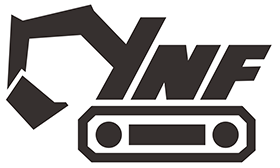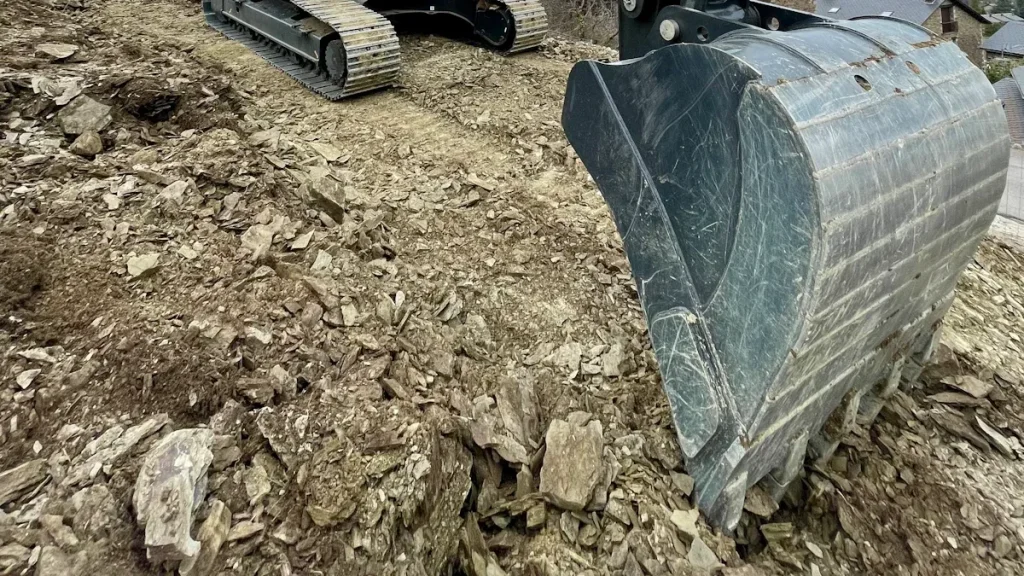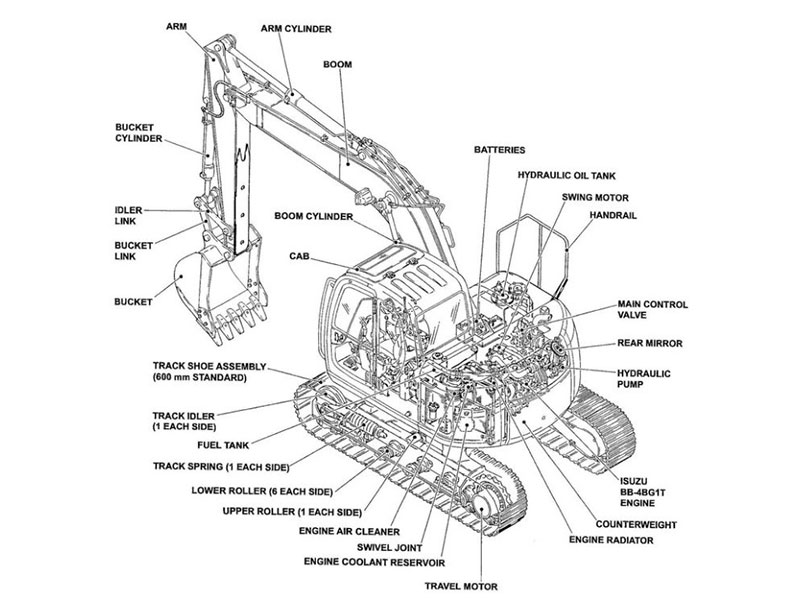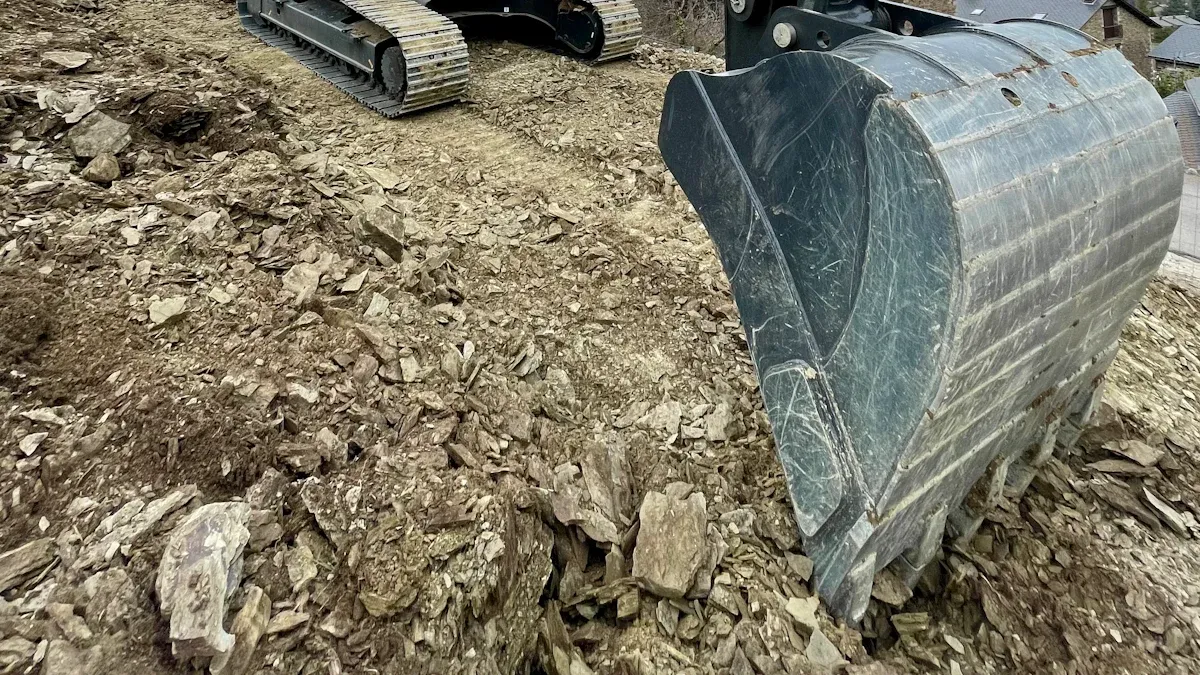
An aftermarket excavator parts factory creates replacement parts for excavators that do not come from the original manufacturer. These factories design, produce, and supply parts such as hydraulic components, undercarriage items, and suspension pieces. The aftermarket excavator parts factory plays a vital role in keeping machines running and reducing downtime for owners.
The Suspension Parts of Excavators Market reached USD 4.5 Billion in 2024 and is expected to grow to USD 6.9 Billion by 2033, showing strong demand for aftermarket parts.
The aftermarket parts market grows as construction machinery becomes more complex.
Major brands like Kubota and John Deere expand aftermarket production and offer more choices.
Urbanization and new technology drive higher demand for quality parts in the excavator industry.
Key Takeaways
Aftermarket excavator parts factories make replacement parts that keep machines running longer and cost less than original parts.
These factories use advanced materials and strict quality checks to ensure parts fit well and last, helping reduce downtime and repair costs.
Aftermarket parts offer more choices and wider availability, especially for older or hard-to-find models, supporting many industries worldwide.
Choosing a reliable factory means checking certifications, customer reviews, and good after-sales support to ensure safety and performance.
Using quality aftermarket parts helps save money, supports sustainability, and keeps excavators working efficiently in demanding jobs.
Aftermarket Excavator Parts Factory Overview
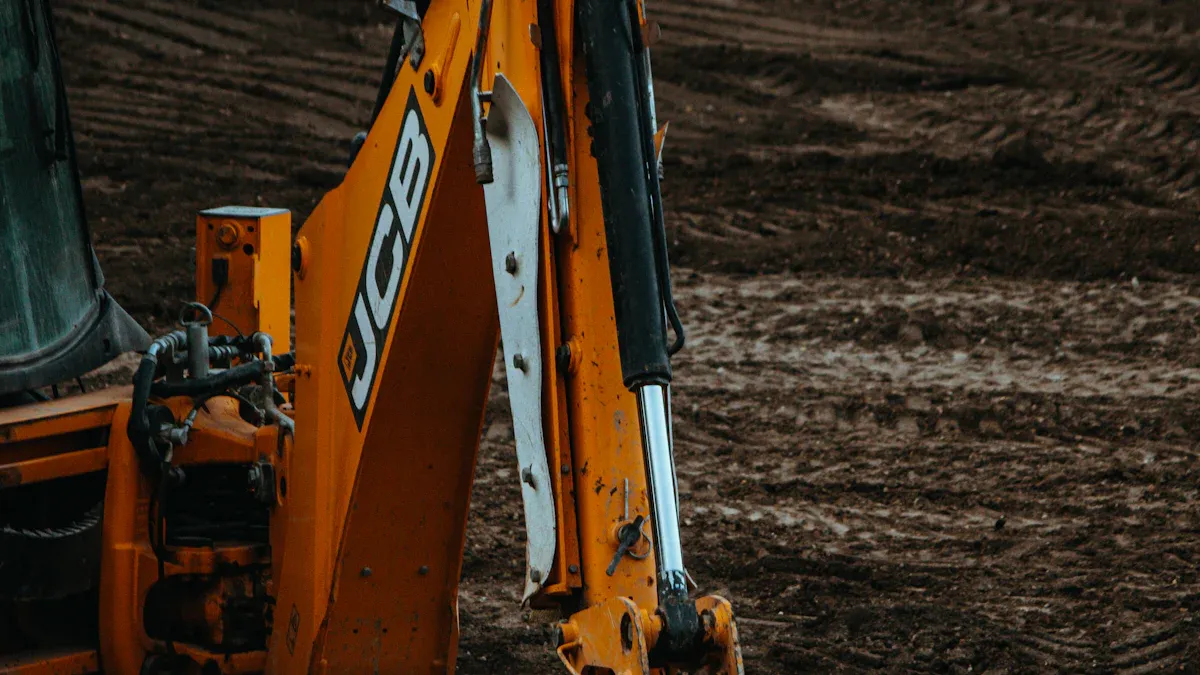
What Is an Aftermarket Excavator Parts Factory
An aftermarket excavator parts factory specializes in producing replacement parts for excavators that do not come directly from the original equipment manufacturer. These factories design, engineer, and manufacture a wide range of excavator spare parts. The main goal is to offer reliable alternatives to OEM components, helping owners keep their machines running efficiently.
The market for aftermarket spare parts continues to grow. Factories supply parts such as hydraulic pumps, engine parts, undercarriage components, and attachments. They serve many types of heavy equipment, including excavators, loaders, bulldozers, and cranes. The demand for these parts comes from industries like construction, mining, agriculture, and public infrastructure.
Note: Aftermarket excavator parts factories often use advanced materials and technology to improve durability and performance. Many factories now use high-strength steel alloys, composite materials, and automated production lines.
The following table summarizes key performance metrics and market data for the aftermarket excavator parts factory sector:
Metric/Aspect | Details |
|---|---|
Market Size (2024) | USD 29.44 Billion |
Projected Market Size (2033) | USD 45.9 Billion |
CAGR (2024-2033) | 5.4% |
Market Segmentation by Type | Engine Parts, Undercarriage Parts, Hydraulic Parts, Others |
Market Segmentation by Application | Excavator, Loaders, Compactors, Dump Trucks, Bulldozers, Others |
Key Excavator Parts | Buckets, Hydraulic Cylinders, Swing Gears |
Performance Impact | Enhances equipment efficiency, durability, reduces downtime and maintenance costs |
Leading Companies | Caterpillar, Komatsu, Hitachi |
Technological Advancements | High-performance engine parts improve fuel efficiency and reduce emissions |
Market Drivers | Infrastructure investment, demand for durable and efficient spare parts |
Aftermarket excavator parts factories also segment their products by type, equipment, and end user. They offer new, rebuilt, remanufactured, and used parts. The factories serve residential, commercial, industrial, and public infrastructure projects. Asia-Pacific leads the market, with North America and Europe following closely.
Role in the Excavator Industry
Aftermarket excavator parts factories play a crucial role in the excavator industry. They help reduce downtime by providing quick access to excavator spare parts. Owners and operators rely on these factories for cost-effective solutions when original parts are unavailable or too expensive.
The following table highlights the operational effectiveness and industry impact of aftermarket spare parts:
Evidence Aspect | Supporting Details |
|---|---|
Historical and Current Demand | High replacement rates for parts like track chains, rollers, sprockets, and idlers due to wear in construction, mining, agriculture, and industrial sectors. |
Market Growth Drivers | Global infrastructure development, rising construction activity, and technological advancements in materials and manufacturing processes. |
Technological Advancements | Use of high-strength steel alloys and composite materials; automation in manufacturing; sustainable and eco-friendly production practices. |
Leading Manufacturers | ITM – Titan International Inc., Berco, VemaTrack, among others, investing in advanced manufacturing and sustainability. |
Operational Effectiveness | Innovations enhancing durability, reducing maintenance costs, and minimizing downtime, critical for productivity in demanding sectors. |
Market Structure | Moderately concentrated market with established players and ongoing mergers and acquisitions indicating maturity and effectiveness. |
Regional Influence | Asia-Pacific dominance driven by government infrastructure investments, especially in China, fueling demand for aftermarket parts. |
Industry Challenges | Raw material price fluctuations, competition from low-cost manufacturers, and stringent environmental regulations. |
Emerging Trends | Adoption of advanced materials, increased automation, and focus on sustainability in production processes. |
Market Size and Forecast | Estimated $15 billion in 2025, projected to grow at 6% CAGR to $25 billion by 2033, reflecting robust demand and industry growth. |
Aftermarket spare parts factories help excavator owners save money. Remanufactured parts can reduce costs by 40-70% compared to new components. This cost savings allows companies to maintain profitability, especially in mining and construction. The use of aftermarket excavator parts factory products also supports sustainability. Remanufacturing and recycling parts lower the environmental impact.
Key roles of aftermarket excavator parts factories include:
Supplying a wide range of excavator spare parts for different brands and models.
Supporting equipment longevity by making replacement parts available even after OEMs stop production.
Driving innovation by adopting new materials and automated manufacturing.
Meeting the needs of global markets, especially in regions with rapid infrastructure growth.
The aftermarket excavator parts factory sector continues to expand as demand for efficient, durable, and affordable parts rises. These factories help keep excavators working longer and more reliably, supporting construction and development worldwide.
Aftermarket Spare Parts Production
Sourcing and Design
Aftermarket excavator parts factories begin by sourcing high-quality materials from trusted suppliers. They look for steel, rubber, and other materials that meet strict standards. Many factories use supplier relationship management tools to build strong partnerships. These tools help factories track supplier performance and improve efficiency. Companies like Toyota and Honda show that sharing information and working closely with suppliers leads to better results.
Factories often use reverse engineering to create aftermarket spare parts. Engineers study original parts and measure every detail. They use advanced tools to scan and model the parts. This process helps them match or even improve the design of OEM spare parts. Factories also listen to customer feedback. They learn which excavator spare parts wear out quickly or need better performance. Designers then make changes to improve durability or fit.
UrParts.com, a global parts network, shows that buyers want quick and reliable service. They value trust and clear communication when choosing aftermarket parts. Factories must evaluate vendors carefully, looking at experience, customer service, and after-sales support. They also consider the total cost of ownership, not just the purchase price.
The table below compares key criteria between OEM and aftermarket parts:
Criteria | OEM Parts | Aftermarket Parts |
|---|---|---|
Cost | Higher, premium pricing | More affordable, cost-effective |
Quality | Meets original specifications | Can match or exceed OEM quality |
Availability | Limited to manufacturer supply | Broader, includes older models |
Compatibility | Guaranteed fit and function | Careful verification needed |
Warranty | Maintains equipment warranty | May void warranty if not OEM |
Risk | Low risk of poor quality | Risk of variable quality |
Flexibility | Less flexible sourcing | Multiple suppliers, more options |
Factories use strategic sourcing to avoid supply chain problems. They work with authorized manufacturers and proven logistics partners. They also use digital tools to track orders and manage inventory. This approach helps them deliver aftermarket spare parts quickly and safely.
Manufacturing Process
Aftermarket excavator parts factories use several advanced manufacturing techniques. The process starts with careful raw material selection. Factories choose materials that offer strength and durability. Next, they use casting to shape parts like track rollers. High-precision molds help create accurate shapes.
Heat treatment follows casting. This step uses controlled temperatures to make parts harder and more resistant to wear. Precision machining comes next. Factories use CNC machines to cut and grind parts to exact sizes. This ensures that excavator spare parts fit perfectly and work well.
The table below outlines the main manufacturing stages and techniques:
Manufacturing Stage | Techniques and Details |
|---|---|
Raw Material Selection | Choose materials for quality and durability |
Casting | Use high-precision molds for accurate part shapes |
Heat Treatment | Apply strict temperature control for hardness and wear resistance |
Precision Machining | Use CNC machines for fine cutting and grinding |
Testing and Assembly | Inspect size, hardness, and wear resistance |
Quality Control | Monitor each stage with advanced equipment and ISO standards |
IoT Integration | Use real-time data monitoring for quality traceability |
Emerging Technologies | Explore 3D printing for future production |
Factories also use IoT technology to monitor production in real time. This helps reduce defects and improve traceability. Some factories experiment with 3D printing to make complex parts faster. However, most still rely on proven methods like casting and machining.
Quality Control
Quality control is a top priority for aftermarket spare parts factories. Dedicated staff check every stage of production. They use advanced testing equipment to ensure each part meets strict standards. Many factories hold ISO9001/2015 certification and follow ASTM, AWS, or EN standards.
Quality checks include several steps:
Coordinate measuring machines (CMM) check part dimensions.
Ultrasonic scans find internal flaws.
Magnetic particle tests detect surface defects.
Visual inspections look for obvious problems.
Material hardness tests and tensile strength evaluations confirm durability.
Factories use special methods to prevent counterfeit parts. They add unique IDs, QR codes, or holograms to packaging. Some use digital verification platforms to help buyers check authenticity. Reliable suppliers deliver parts on time and meet all specifications.
Quality control success shows in reduced equipment downtime and better maintenance. Factories that follow strict quality steps help prevent fake or poor-quality parts from entering the supply chain. This keeps excavators running smoothly and safely.
Comparing Aftermarket and OEM Excavator Spare Parts
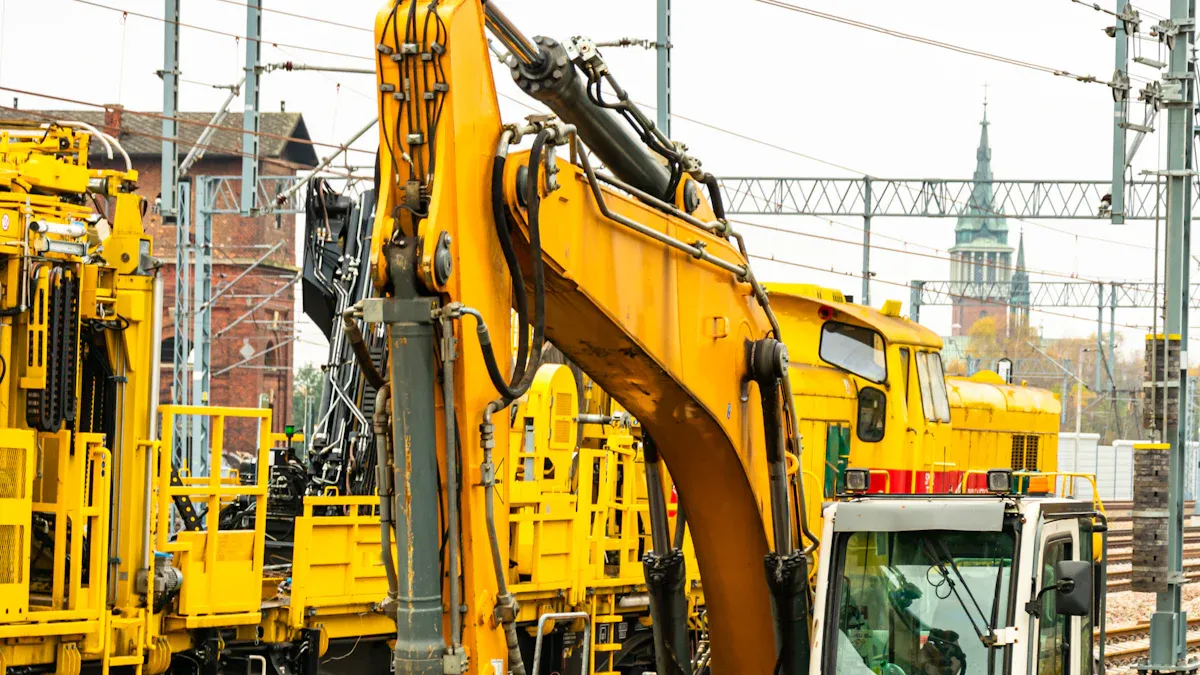
Differences from OEM Parts
OEM spare parts come directly from the original manufacturer. These parts follow strict design drawings and specifications. They guarantee compatibility and performance for each excavator. OEM parts use high-quality materials and advanced manufacturing methods. This leads to higher prices and strong after-sales support. Many customers choose original spare parts for reliability and warranty protection.
Aftermarket spare parts offer alternatives to OEM products. Factories design these parts based on customer needs or by improving existing models. Some aftermarket parts match or even exceed OEM quality. Others focus on lower cost and wider availability. The aftermarket sector includes new, remanufactured, and refurbished parts. These options help excavator owners save money and keep machines running longer.
Market research shows that aftermarket spare parts now compete closely with original spare parts in quality and performance. The oem vs. aftermarket debate often centers on cost, warranty, and long-term value.
Aspect | OEM Model Characteristics | ODM Model Characteristics |
|---|---|---|
Design Participation | Production strictly follows purchaser’s design drawings and specifications | Manufacturer responsible for design; purchaser provides requirements |
Customization Level | Standardized, high replication | High customization with functional integration and structural innovation |
Quality Control Focus | Stable production and inspection processes | Dual control combining design verification and production inspection |
Differences from Dealers
Dealers act as middlemen between manufacturers and customers. They sell both OEM and aftermarket spare parts. Dealers often focus on after-sales service, which brings higher profit margins than equipment sales. Many customers rely on dealers for convenience and support.
Aftermarket factories supply excavator spare parts directly or through distributors. They can offer a broader product range and faster delivery. Dealers may have limited stock or higher prices due to markups. The oem vs. aftermarket choice depends on service needs, price, and part availability.
Aspect | Dealers (Conventional) | OEMs (Aftermarket Factories) |
|---|---|---|
After-Sales Service Margin | High, gross margins 30%+ on parts and service | Aftermarket services and parts represent over 50% of total machine lifecycle profit |
Profit Source Focus | After-sales service is primary profit source | Aftermarket parts and services are key profit drivers |
Unique Benefits of Aftermarket Factories
Aftermarket factories bring several advantages to the excavator industry:
They provide a wide selection of excavator spare parts for many brands and models.
They offer cost-effective solutions, especially for older equipment.
They use innovative designs and materials to improve performance.
They support sustainability by remanufacturing and refurbishing parts.
The oem vs. aftermarket comparison shows that aftermarket spare parts increase competition and give customers more choices. Many excavator owners now use aftermarket spare parts to reduce costs and extend machine life. Aftermarket factories help keep equipment running, even when original spare parts are hard to find.
Benefits and Challenges for Excavator Owners
Cost and Availability
Excavator owners often look for ways to save money and keep their machines running. Aftermarket excavator spare parts offer several cost and availability benefits:
Buyers can achieve significant cost savings by choosing used or refurbished excavators and parts, especially from markets like China. These options help businesses build fleets without high upfront costs.
The global presence of many brands means a wide selection of parts is available. Owners can find parts for different models, even older ones, which helps with ongoing maintenance.
Used and refurbished mini excavators provide a balance between reliability and cost savings. These machines often come with some warranty, making them a smart choice for many buyers.
Market price research is easy through manufacturer websites and equipment listing platforms. This helps owners compare prices and make informed decisions.
Quick access to parts reduces downtime and keeps excavators working longer.
Tip: Buying used or refurbished excavator spare parts can extend machine life and reduce environmental impact.
Quality and Compatibility
Quality and compatibility matter when choosing excavator spare parts. Owners want parts that fit well and last a long time. Many aftermarket factories use strict quality control to match or exceed original standards. Reliable parts help keep excavators safe and efficient during maintenance and repairs.
A table below shows what owners should check for:
What to Check | Why It Matters |
|---|---|
Material and Build | Ensures durability and performance |
Model Compatibility | Prevents fitting and function issues |
Warranty Availability | Protects against faulty parts |
Supplier Reputation | Reduces risk of poor-quality parts |
Choosing the right parts supports smooth maintenance and reduces the risk of breakdowns.
Common Challenges
Excavator owners face some challenges when using aftermarket spare parts:
Quality assurance problems can happen if parts come from unreliable sources. Some parts may use poor materials or lack proper testing.
Compatibility issues may arise, especially with mini excavator models. Parts that do not fit can cause more repairs.
Safety risks increase when using inferior parts, such as spindles or seals. These can lead to mechanical failures.
Owners may face higher long-term costs if they need frequent repairs or replacements.
Counterfeit parts often have poor packaging, non-matching part numbers, and no warranty. These parts do not meet original standards and can reduce machine efficiency.
Note: Regular inspection and timely replacement of parts help maintain excavator performance and safety. Professional help is important for complex maintenance tasks.
Choosing an Aftermarket Excavator Parts Factory
Quality Standards
Selecting the right aftermarket factory starts with checking their commitment to quality standards. Reliable factories use strict testing and follow industry guidelines for every part they produce. They often hold certifications like ISO9001, which shows they meet global standards. When a factory uses high-quality materials and tests each part, the risk of failure drops. For example, using cheap replacement parts can cause engine damage or other costly repairs. High-quality parts last longer and help prevent breakdowns. Contractors have found that using better parts and regular maintenance can cut equipment failures in half. This approach also lowers maintenance costs and keeps excavators working longer. Factories that focus on quality help owners avoid unexpected downtime and expensive repairs.
Tip: Always ask for proof of certification and details about the factory’s testing process before making a purchase.
Reputation and Support
A factory’s reputation tells a lot about its reliability. Owners should look for factories with positive reviews and a strong track record in the excavator industry. Good factories respond quickly to questions and offer clear information about their parts. They also provide after-sales support, such as warranties and technical help. This support makes it easier to solve problems if they arise. Many top factories have customer service teams that help with installation or troubleshooting. Checking online forums and industry groups can help owners find trusted suppliers. Choosing a factory with a good reputation and strong support ensures a better experience and safer equipment operation.
What to Look For | Why It Matters |
|---|---|
Positive Customer Reviews | Shows trust and reliability |
Responsive Service | Helps solve issues quickly |
Warranty and Support | Protects your investment |
An aftermarket excavator parts factory produces replacement parts that keep machines running. These factories help owners find affordable and reliable spare parts. They use strict quality checks and advanced technology. Key benefits include lower costs, wide part selection, and strong support. When choosing a factory, buyers should check for certifications, good reviews, and helpful service.
Smart buyers use these tips to select trusted aftermarket suppliers and keep their equipment working safely.
FAQ
What are aftermarket excavator parts?
Aftermarket excavator parts are replacement components made by companies other than the original manufacturer. These parts help keep machines running when OEM parts are unavailable or too expensive. Many owners choose them for cost savings and wide availability.
How can owners check the quality of aftermarket parts?
Owners should look for ISO certifications, positive customer reviews, and clear warranty policies. Reliable factories provide detailed product information and testing results.
Tip: Always ask for proof of quality before buying.
Do aftermarket parts fit all excavator brands?
Most aftermarket factories design parts for many popular brands and models. Owners should check part numbers and specifications before purchase.
Compatibility charts help match parts to specific machines.
Are aftermarket parts safe to use?
High-quality aftermarket parts meet strict safety and performance standards. Factories test these parts for durability and fit. Owners should avoid unverified suppliers to reduce the risk of poor-quality or counterfeit parts.
